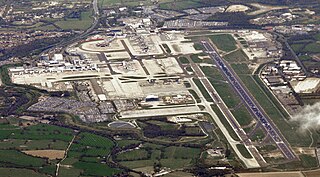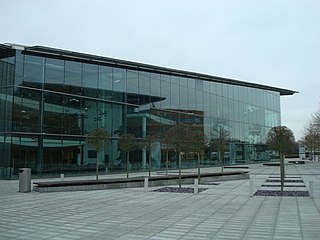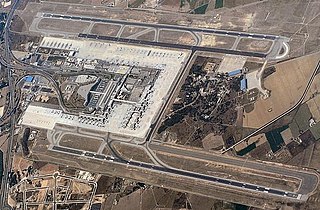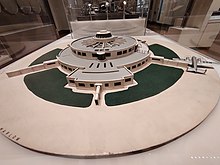Gibraltar has a limited public transport system, due to the compact size of the territory.

Heathrow Airport, called London Airport until 1966 and now known as London Heathrow, is the main international airport serving London, England. It is the largest of the six international airports in the London airport system. The airport is owned and operated by Heathrow Airport Holdings. In 2021, it was the seventh-busiest airport in the world by international passenger traffic and eighth-busiest in Europe by total passenger traffic.

London Stansted Airport is a tertiary international airport serving London, England, United Kingdom. It is located near Stansted Mountfitchet, Essex, England, 42 mi (68 km) northeast of Central London.

Gatwick Airport, also known as London Gatwick, is a major international airport near Crawley, West Sussex, England, 29.5 miles (47.5 km) south of Central London. In 2022, Gatwick was the second-busiest airport by total passenger traffic in the UK, after Heathrow Airport, and was the 8th-busiest in Europe by total passenger traffic. It covers a total area of 674 hectares.
EasyJet plc is a British multinational low-cost airline group headquartered at London Luton Airport. It operates domestic and international scheduled services on 927 routes in more than 34 countries via its affiliate airlines EasyJet UK, EasyJet Switzerland, and EasyJet Europe. EasyJet plc is listed on the London Stock Exchange and is a constituent of the FTSE 250 Index. EasyGroup Holdings Ltd, the investment vehicle of the airline's founder, Greek-Cypriot businessman Stelios Haji-Ioannou, is the largest shareholder with a 15.27% stake. It employs circa 13,000 people, based throughout Europe but mainly in the UK.

London Luton Airport is an international airport located in Luton, Bedfordshire, England, situated 1.5 miles (2.4 km) east of the town centre, and 28 miles (45 km) north of Central London. The airport is owned by London Luton Airport Ltd (LLAL), a company wholly owned by Luton Borough Council, and operated by London Luton Airport Operations Ltd (LLAOL).

London City Airport is a regional airport in London, England. It is located in the Royal Docks in the Borough of Newham, approximately 6 miles (9.7 km) east of the City of London and 3 miles (4.8 km) east of Canary Wharf. These are the twin centres of London's financial industry, which is a major user of the airport. The airport was developed by the engineering company Mowlem in 1986–87. In 2016 it was bought by a Canadian-led consortium of Alberta Investment Management Corporation (AIMCo), OMERS, the Ontario Teachers' Pension Plan and Wren House Infrastructure Management of the Kuwait Investment Authority.

Manchester Airport is an international airport in Ringway, Manchester, England, 7.5 nautical miles south-west of Manchester city centre. In 2019, it was the third busiest airport in the United Kingdom in terms of passenger numbers and the busiest of those not serving London. The airport comprises three passenger terminals and a cargo terminal, and is the only airport in the UK other than Heathrow Airport to operate two runways over 3,280 yd (2,999 m) in length. Manchester Airport covers an area of 560 hectares and has flights to 199 destinations, placing the airport thirteenth globally for total destinations served.

Belfast International Airport is an airport 11.5 NM northwest of Belfast in Northern Ireland, is the main airport for the city of Belfast. Until 1983, it was known as Aldergrove Airport, after the nearby village of Aldergrove. In 2018, over 6.2 million passengers travelled through the airport, a 7.4% increase compared with 2017. The majority of flights from Belfast International are operated by easyJet, Northern Ireland's biggest airline. It features flights to some European metropolitan and several leisure destinations.

Aberdeen International Airport is an international airport, located in the Dyce suburb of Aberdeen, Scotland, approximately 5 nautical miles northwest of Aberdeen city centre. A total of just under 3.1 million passengers used the airport in 2017, an increase of 4.6% compared with 2016.

GB Airways was a British airline; prior to its sale, it was headquartered in "The Beehive," a former terminal building, at City Place Gatwick, London Gatwick Airport in Crawley, West Sussex, England.

Gibraltar International Airport or North Front Airport is the civilian airport that serves the British overseas territory of Gibraltar. The runway is owned by the Ministry of Defence for use by the Royal Air Force as RAF Gibraltar. Civilian operators use the civilian-operated terminal. National Air Traffic Services hold the contract for provision of air navigation services at the airport.

Málaga Airport, officially Málaga–Costa del Sol Airport since June 2011, is the fourth busiest airport in Spain after Madrid–Barajas, Barcelona and Palma de Mallorca. It is significant for Spanish tourism as the main international airport serving the Costa del Sol. It is 8 km (5.0 mi) southwest of Málaga and 5 km (3.1 mi) north of Torremolinos. The airport has flight connections to over 60 countries worldwide, and over 14.4 million passengers passed through it in 2015. In 2017, 18.6 million passengers passed through Málaga Airport.

Menorca Airport, also known as Mahón Menorca Airport is an international airport serving the island of Menorca, one of Spain's Balearic Islands in the Mediterranean Sea. The airport is located 4.5 km (2.8 mi) southwest of the city of Mahón. The airport is primarily used by charter and seasonal flights and is busiest during the April-October season. In 2019, the airport handled over 3 million passengers, making it the fifteenth busiest airport in the country that year.

Lowfield Heath is a former village within the boundaries of the Borough of Crawley, West Sussex, England. Situated on the main London to Brighton road approximately 27 miles (43 km) south of London and 2 miles (3.2 km) north of Crawley, it was gradually rendered uninhabitable by the expansion of London Gatwick Airport immediately to the north.

Tinsley Green is an area in the Borough of Crawley, one of seven local government districts in the English county of West Sussex. Originally a hamlet in the parish of Worth, it was absorbed by the New Town of Crawley in the 1940s and became part of the Pound Hill neighbourhood. As well as houses, farms and woodland, it became the site of the 1930s aerodrome at Gatwick—now London Gatwick Airport. The airport's first railway station was briefly known as Tinsley Green. The game of marbles has a strong local tradition, and Tinsley Green's pub hosts the British and World Marbles Championship each year.

City Place Gatwick is an office complex located on the property of London Gatwick Airport in Crawley, West Sussex, England. The complex includes four buildings: The Beehive, an approximately 20,000-square-foot (1,900 m2) former terminal building at Gatwick Airport located on a 2.0-acre (0.81 ha) site; 1 City Place a 131,500-square-foot (12,220 m2) facility on a 4.2-acre (1.7 ha) site, 2 City Place, a 85,000-square-foot (7,900 m2) building on a 1.9 acres (0.77 ha) plot, and 3 City Place, a 65,000-square-foot (6,000 m2) building on a 1.06-acre (0.43 ha) plot. Hamiltons Architects designed the "L" shaped 3 City Place.

Palma de Mallorca Airport is an international airport located 8 km (5.0 mi) east of Palma, Mallorca, Spain, adjacent to the village of Can Pastilla. In 2020, the airport handled 6.1 million passengers, making it the third busiest airport in Spain, after Madrid–Barajas and Barcelona-El Prat. The airport is the main base for the Spanish carrier Air Europa and also a focus airport for Eurowings, EasyJet, Jet2.com, Ryanair and Vueling. The airport shares runways with the nearby Son Sant Joan Air Force Base, operated by the Spanish Air and Space Force.
In its early years what is now Heathrow Airport was the Great West Aerodrome, sometimes known as Heathrow Aerodrome.
Gatwick Airport was in Surrey until 1974, when it became part of West Sussex as a result of a county boundary change. The original, pre-World War II airport was built on the site of a manor in the parish of Charlwood. The land was first used as an aerodrome in the 1920s, and in 1933 commercial flights there were approved by the Air Ministry.



















